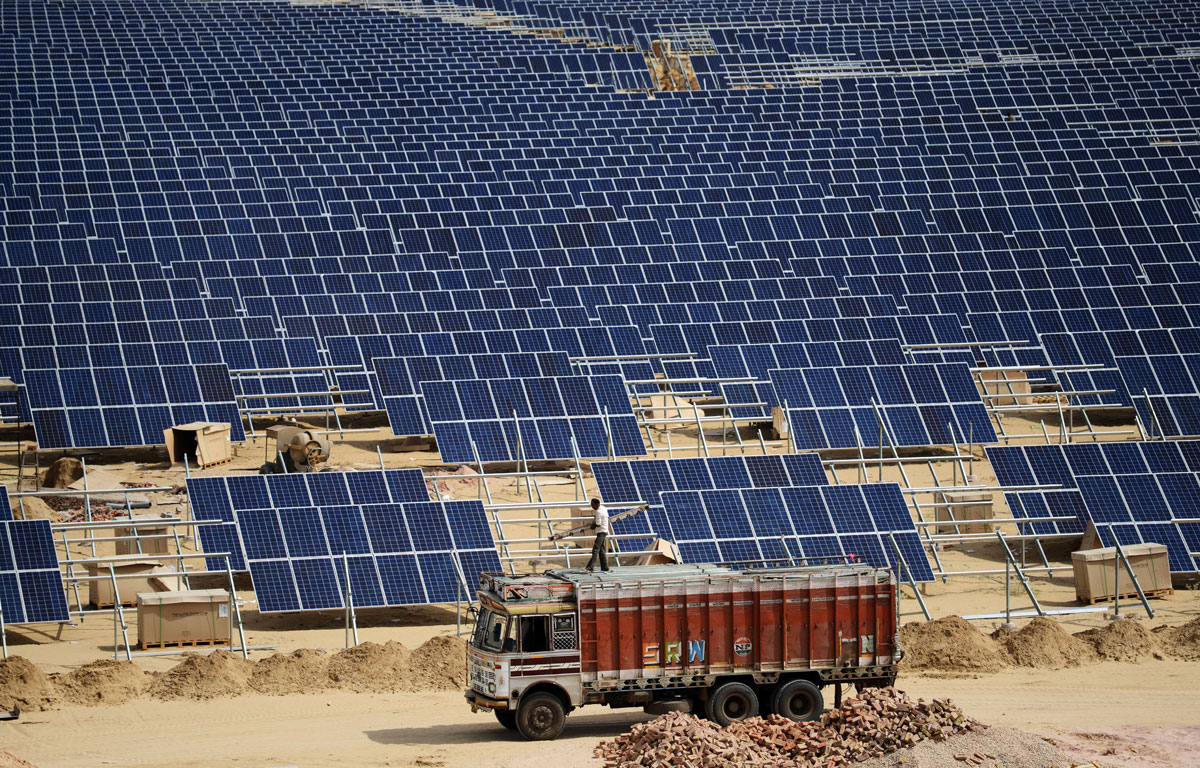GETTING CREATIVE
An Indian engineer positions solar panels at the under construction Roha Dyechem solar plant at Bhadla some 225 kms north of Jodhpur, Rajasthan. Under a blistering sun, workers install a sea of solar panels in a north Indian desert as part of the government’s clean energy push. (Money Sharma | AFP | Getty Images)
The Modi government has been struggling in the recent times, to deal with the situation in Kashmir, where security forces have been involved in pitched battles with the youth, that has left scores dead and others grievously injured due to use of pellet guns. New Delhi, thankfully, is thinking ahead in its efforts to enable industry in India to progress by taking on one of the biggest bottlenecks to growth: land acquisition. The government is also looking to make dynamic policy changes in keeping with feedback from stakeholders, writes Siddharth Srivastava. – @siliconeer #siliconeer #narendramodi #namo #SiliconValley #thinkingdifferent #Indiaindustrygrowth #renewableenergy #SunEdison #AdaniGroup #FortumOyj #solarparks #solar #wind
Reflected in Prime Minister Narendra Modi’s pet project, renewable energy, the government recently announced that it intends to double the target of clean power to be generated from solar parks by 2020 to 40,000 MW. The move to build more solar parks is recognition of the growing popularity of the scheme with developers as the infrastructure, including transmission linkages are already provided by the government, which also acquires the land. This is critical as land acquisition in India is a politically sensitive subject and many mega projects have been abandoned or indefinitely stalled due to violent opposition to the process. The resistance relates to reluctance to part with land, pricing and fear of coercion and being shortchanged.
The new solar parks will also help plug some of the several loopholes spoken about India’s solar program that could jeopardize the massive target to generate 100,000 MW of sun power by 2022, which includes 40,000 MW from rooftop units. The worries include slower than anticipated progress in rooftop installations. Despite efforts by the government, rooftop projects in India essentially remain an institutional exercise that are popular with hospitals, government offices, schools and colleges. Given the trend, it will be difficult to achieve the target as individual households are reluctant to take the plunge due to doubts about efficacy and the high initial cost involved.

The government also fears that it needs to buffer against the possibility that some companies may have bid too low, in the face of fierce competition, and may not be in a position to deliver large scale projects, thus affecting the overall achievement of target. One such instance is the scenario arising out of the bankruptcy of SunEdison due to which the entity is reportedly in stake-sale talks with Adani Group and Finland’s Fortum Oyj. It remains to be seen whether SunEdison will be able to sell its assets in India, including the 500 MW Andhra Pradesh project that it won by bidding at a record-low tariff, at that time, of Rs 4.63 per kilowatt-hour (kwH). While one cannot ignore apprehensions that solar developers may have bid too low, the good news is that the cost of generation is expected to fall further, doing by the global dynamics that is emerging.
Developments in China are being closely watched as the country is the biggest supplier of solar equipment to India. In a recent report, Bridge to India, a renewable analysis firm, has said an oversupply situation is developing in photo-voltaic module manufacturing in China, especially for the second half of 2016, which could lead to significant price corrections that will benefit India.
Analysts from IHS research have estimated that photo-voltaic installations in China in third quarter 2016 may drop by as much as 80%, due to achievement of targets set by the government. This will suit India quite well as the first quarter 2017 is expected to witness the highest new capacity addition in the country. A perceptible depreciation of the Chinese Yuan against the Indian Rupee is further lowering import cost of modules. Apart from the reassuring cost figures, the bullishness about India’s renewable program, especially solar and wind, is resulting in flow of essential capital.
India, for instance, has secured a $1 billion loan from the World Bank mainly to support rooftop units. New Delhi has estimated $90 billion is needed for India to achieve its solar goals. Without doubt, the thought process behind setting up more solar parks is creditable. The government has done well so far to identify 33 solar parks in 21 states in India with capacity to produce 20,000 MW.
Creating more solar parks further on, however, will not be easy due to rising price of real estate and complex acquisition processes. There are already complaints that many solar parks are located too far from high power consumption areas, which raises transmission costs considerably. This limits the ability to compete with cheap thermal power. There is also the risk of underutilization of capacity created due to lack of evacuation, as has happened in the case of coal-fired plants. In such a scenario, it will be imperative for the government not to lose focus from rooftop solar, plug the leakages and incentivize installations.
Given limitations of mega projects due to need for infrastructure support, land and proximity to consumers, it is important that India continues to push for decentralized generation by individual households. Indeed, even as Kashmir erupts in violence yet again, it is to the credit of the Modi government that it is looking to stick to its goal of delivering clean power to the country.


